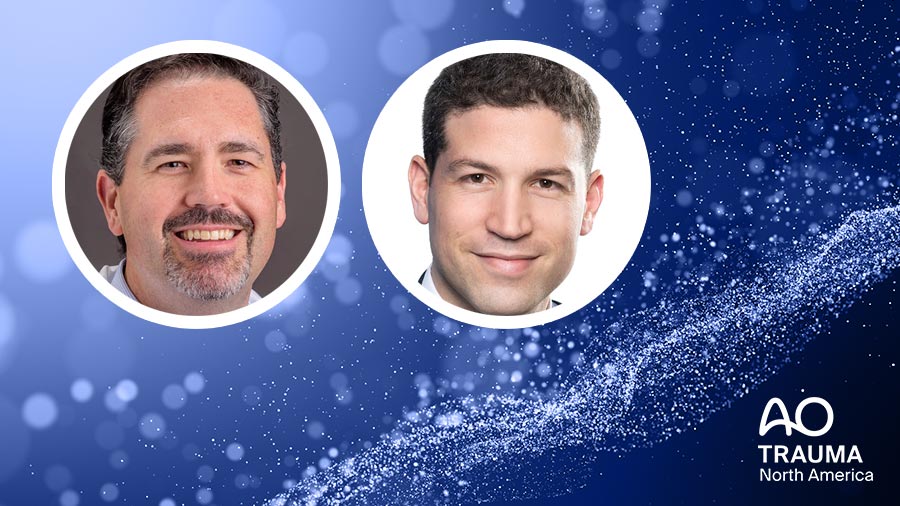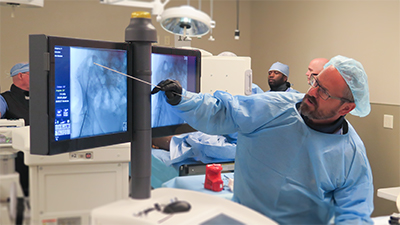AO Trauma NA Fireside series facilitates interactive and practical online learning opportunities

What were the highlights of the 2021 Fireside series?
Mitchell Bernstein, MD, FRCSC, FAAOS: The highlights were the participation. We had an amazing audience of learners from not only the United States, Canada, but around the world. The passion for teaching was another highlight. Brett and I organized it with some amazing colleagues of ours. It was seamless and easy to work with these very talented people.
Brett Crist, MD: Not only was it seamless working with the faculty, the faculty interaction between each other and the participants was also great. I thought the sessions went smoothly and it was just a great learning environment for interaction as well as responding to participant questions.
Dr. Bernstein: I was speaking with one of the learners who I'm working with now, he commented on the fact that it was down-to-earth. We worked to make it very pragmatic. We wanted to mix practical with evidence-based best practices. Some of the feedback that I really liked was the fact that it was easily digested by the audience.
Could you describe any particularly successful or memorable moments from the sessions?
Dr. Crist: I think the distal radius session went well in terms of faculty interaction. It was Mitch's idea to have them go through an article, which was a great way to tie in the literature and not just anecdotal experience.
Dr. Bernstein: The proximal humerus session was very memorable for me because I had a case the next day of the same fracture. I was listening very attentively to three mentors of mine, and I used their advice the subsequent day in the operating room.
That's what we're trying to do: make it practical and have the audience, the learners, and our colleagues really apply things to that. We weren't trying to be very abstract. And we promoted a lot of discussion—we did not want it to be a webinar.
Dr. Crist: That was definitely the flavor. The feedback I got is that it was more than just information session. The video that Mitch did for the young femoral neck fracture session, having the video of the approach and giving tips while he was going through it was particularly helpful. Those happen in webinars, but it was interactive: we got to ask questions while it was happening or right afterwards. I thought that was particularly helpful.
What are you planning for future series?
Dr. Crist: The number of participants that we had consistently throughout the Firesides was awesome. People continued to come back and that validates the efforts that Mitch, the faculty, and the staff put in to make it successful.
I think the fireside format works better than a standard webinar. We can have minor changes, but the overall format is the interactivity. That will be a major component of any online offering that we do.
Tune in to the Fireside Series 2022
Sessions occurring April 5 through June 7
Why is it important to continue having opportunities like the Fireside series?
Dr. Bernstein: I think engagement is one: to engage the faculty and our orthopedic colleagues across North America globally so we can share best practices. And that ultimately helps our patients, which we're all passionate about doing. It's not meant to be intimidating. It's meant to be for learning.
Leveraging Zoom™ and technology like 4K ultra-HD video, really taking the operating room to a Zoom™ meeting and having a surgeon talk about the case and some of the nuances live. Using all these creative tools within Zoom™ is very helpful—polling the audience live so we can get feedback and what levels, what knowledge gaps there exists. And then the faculty, they're very versatile, they can shift some of their educational strategies based on that.
Dr. Crist: It's important to do online offerings because, number one, people, learners are wanting it. People don't always want to travel to do courses. They want to have something that's readily available at their fingertips at any time during their week. Even having things available offline after the event is important as a resource.
Also, most of the time if you ask people to ask a question themselves, they don't really—that can be intimidating. Using a moderator like we do is probably the easiest way to engage the participants and get their questions answered during the live event.
All of us are part of this AO family because of the interactions with faculty or co-learners that we've engaged with over the years, the camaraderie and the mentoring aspects are such a significant part of it. I think that's critical to continue to do online as well as in-person.
How do you think this series embodies the spirit and values of North America?
Dr. Crist: I think Mitch kind of hit the nail on the head a little bit earlier. The AO is meant to improve patient care through education. About five years ago, somebody asked how many residents I trained—it would have been around fifty-five residents. That's a lot of residents. I was like, wow, that's a lot of responsibility. But we had sometimes two hundred participants viewing these educational offerings from around the world.
That's one of the things about the AO mission: you train people to affect more patients. It's an exponential growth, rather than me training fifty-five residents over my career at the time, the AO touches thousands upon thousands each year. That's why I think it embodies the spirit of the AO—just with the reach.
That's one of the good things that's come about out of COVID. Our online presence has significantly increased via the YouTube channel and via these offerings that we have available. I've been impressed with how many people have viewed the educational offerings, and it should just reinforce that this needs to continue.
Dr. Bernstein: I like the word facilitate. The AO and Brett—with this Fireside they helped facilitate these learning opportunities and they support personal and career growth as well. While I was leading the Fireside series, which is a pretty big machine, Brett mentored me and worked with me, and we had the full force of the AO NA staff and educational leaders behind us. It's that facilitation of ideas, something which is not present in a lot of institutions.
Dr. Crist: To piggyback on that a little bit: it was awesome. Senior AO members sent comments via email or text messages after a session. It's great to get that positive feedback from senior leadership.
Final thoughts
Dr. Bernstein: I just want to thank Brett very much for his mentorship and helping me throughout the years within AO NA. And I'm not going to name the AO NA staff because I will certainly leave out someone, but they are an amazing group of people. They're amazing, right? I mean, it's amazing working with them.
Dr. Crist: Yeah, the wheels would come off the bus without the staff. We appreciate everyone's willingness to do what you're doing. We appreciate your attention and efforts in making the product that we put out there the best that it can be. And I appreciate Mitch's words, he's made it very easy to mentor. He's a great educator, great surgeon, and it's been a pleasure working with him on this project and others, and we'll continue to work with him.
Interested in experiencing one of these interactive online forums for yourself?
Join us at an upcoming Fireside Series 2022 session.
Related pages

AO Trauma NA Pelvic & Acetabular Fracture Management
Gain specialized and hands-on knowledge regarding techniques for evaluating and managing pelvic and acetabular fractures with human anatomic specimens

Kathryn Cramer Career Development Award
This grant supports senior orthopedic residents, orthopedic trauma fellows, and junior orthopedic trauma faculty who are interested in educational and research endeavors in orthopedics (preferably orthopedic trauma).
